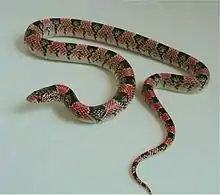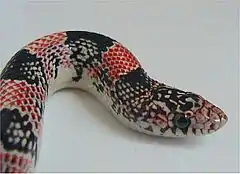Long-nosed snake
The long-nosed snake (Rhinocheilus lecontei ) is a species of nonvenomous snake in the family Colubridae. The species is endemic to North America. It has two recognized subspecies. The other species in the genus were previously considered subspecies.
| Long-nosed snake | |
|---|---|
 | |
| Texas long-nosed snake Rhinocheilus lecontei tessellatus | |
| Scientific classification | |
| Kingdom: | Animalia |
| Phylum: | Chordata |
| Class: | Reptilia |
| Order: | Squamata |
| Suborder: | Serpentes |
| Family: | Colubridae |
| Genus: | Rhinocheilus |
| Species: | R. lecontei |
| Binomial name | |
| Rhinocheilus lecontei | |
| Synonyms | |
Etymology
The specific name, lecontei, commemorates American entomologist John Lawrence Le Conte (1825-1883).[4]
Description
The long-nosed snake is distinguished by a long, slightly upturned snout, which is the origin of its common name. It is tricolor, vaguely resembling a coral snake with black and red saddling that almost looks like banding, on a yellow or cream-colored background, which can look somewhat like yellow banding. Cream-colored spots within the black saddles are a distinct characteristic of the long-nosed snake. It differs from all other harmless snakes in the United States by having undivided subcaudal scales.[5] They average around 30 inches (76 cm) in total length.
Behavior
R. lecontei is a shy, nocturnal burrowing snake. It spends most of its time buried underground.
Diet
The long-nosed snake feeds on lizards, amphibians, and sometimes smaller snakes and infrequently rodents.
Reproduction
R. lecontei is oviparous, laying clutches of 4-9 eggs in the early summer, which hatch in the late summer or early fall.
Defense
The long-nosed snake is not apt to bite, but will release a foul smelling musk and blood[6] from the cloaca as a defense mechanism if harassed.
Habitat
The long-nosed snakes inhabits dry, often rocky, grassland areas.
Geographic range
R. lecontei is found in northern Mexico from San Luis Potosí to Chihuahua, and into the southwestern United States, in California, Nevada, Utah, Idaho, Arizona, New Mexico, southeastern Colorado, southwestern Kansas,[7] Oklahoma,[8] and Texas.[7]
Subspecies
- Western long-nosed snake, Rhinocheilus lecontei lecontei Baird & Girard, 1853
- Texas long-nosed snake, Rhinocheilus lecontei tessellatus Garman, 1883

In captivity
The long-nosed snake is not often found in the exotic pet trade as it frequently rejects rodent-based diets that are most readily available for captive snakes.
References
- Cope ED (1866). "On the REPTILIA and BATRACHIA of the Sonoran Province of the Nearctic Region". Proc. Acad. Nat. Sci. Philadelphia. "1866" [18]: 300-314. ("Rhinochilus [sic] lecontei ", p. 304).
- Boulenger GA (1894). Catalogue of the Snakes in the British Museum (Natural History). Volume II., Containing the Conclusion of the Colubridæ Aglyphæ. London: Trustees of the British Museum (Natural History). (Taylor and Francis, printers). xi + 382 pp. + Plates I-XX. ("Rhinochilus [sic] lecontii ", pp. 212-213).
- Stejneger L, Barbour T (1917). A Check List of North American Amphibians and Reptiles. Cambridge, Massachusetts: Harvard University Press. 125 pp. (Rhinocheilus lecontei, p. 91).
- Beolens, Bo; Watkins, Michael; Grayson, Michael (2011). The Eponym Dictionary of Reptiles. Baltimore: Johns Hopkins University Press. xiii + 296 pp. ISBN 978-1-4214-0135-5. (Rhinocheilus lecontei, p. 154).
- Schmidt KP, Davis DD (1941). Field Book of Snakes of the United States and Canada. New York: G.P. Putnam's Sons. 365 pp. (Rhinocheilus lecontei, pp. 194-196, Figure 61 + Plate 21).
- McCoy CJ Jr, Bianculli AV (1966). "Defensive behavior of Rhinocheilus lecontei ". Journal of the Ohio Herpetological Society 5 (4): 166.
- "Rhinocheilus lecontei ". The Reptile Database. www.reptile-database.org.
- T. Robyn captured, identified, and released one near Lawton, Oklahoma, 2010.
External links
- Species Rhinocheilus lecontei at The Reptile Database
- USGS: Rhinocheilus lecontei
- "IUCN Red List of Threatened Species". Retrieved 2008-09-06.
| Wikimedia Commons has media related to Rhinocheilus lecontei. |
- WhoZoo: Long-nosed Snake
- NatureServe Explorer: w/ 2 RangeMaps: Rhinocheilus lecontei. Click "DISTRIBUTION" for maps.
Further reading
- Baird SF, Girard C (1853). Catalogue of North American Reptiles in the Museum of the Smithsonian Institution. Part I.—Serpents. Washington, District of Columbia: Smithsonian Institution. xvi + 172 pp. (Rhinocheilus, new genus, p. 120; R. lecontei, new species, pp. 120–121).
- Behler JL, King FW (1979). The Audubon Society Field Guide to North American Reptiles and Amphibians. New York: Alfred A. Knopf. 743 pp. ISBN 0-394-50824-6. (Rhinocheilus lecontei, pp. 649-650 + Plates 593, 609).
- Conant R, Bridges W (1939). What Snake Is That? A Field Guide to the Snakes of the United States East of the Rocky Mountains. (With 108 drawings by Edmond Malnate). New York and London: D. Appleton-Century Company. Frontispiece map + viii + 163 pp. + Plates A-C, 1-32. (Rhinocheilus lecontei, p. 86 + Plate 14, Figure 41).
- Powell R, Conant R, Collins JT (2016). Peterson Field Guide to Reptiles and Amphibians of Eastern and Central North America, Fourth Edition. Boston and New York: Houghton Mifflin Harcourt. xiv + 494 pp., 47 plates, 207 figures. ISBN 978-0-544-12997-9. (Rhinocheilus lecontei, pp. 392-393 + Plate 37).
- Smith HM, Brodie ED Jr (1982). Reptiles of North America: A Guide to Field Identification. New York: Golden Press. 240 pp. ISBN 0-307-13666-3 (paperback). (Rhinocheilus lecontei, pp. 164–165).
- Stebbins RC (2003). A Field Guide to Western Reptiles and Amphibians, Third Edition. The Peterson Field Guide Series ®. Boston and New York: Houghton Mifflin Company. xiii + 533 pp. ISBN 0-395-98272-3 (paperback). (Rhinocheilus lecontei, pp. 370–371 + Plate 44 + Map 155).
- Wright AH, Wright AA (1957). Handbook of Snakes of the United States and Canada. Ithaca and London: Comstock Publishing Associates, a Division of Cornell University Press. 1,105 pp. (in 2 volumes) (Genus Rhinocheilus, p. 630-633 + Figure 19 on p. 69). (species Rhinocheilus lecontei, pp. 633–644, Figures 183-187, Map 48).
- Zim HS, Smith HM (1956). Reptiles and Amphibians: A Guide to Familiar American Species: A Golden Nature Guide. Revised Edition. New York: Simon and Schuster. 160 pp. ("LONG-NOSED SNAKE", Rhinocheilus lecontei, pp. 101, 156).
